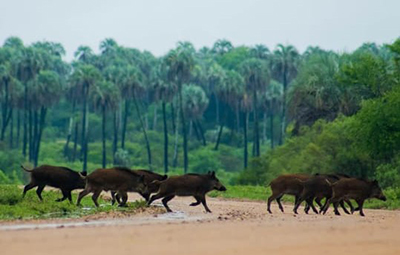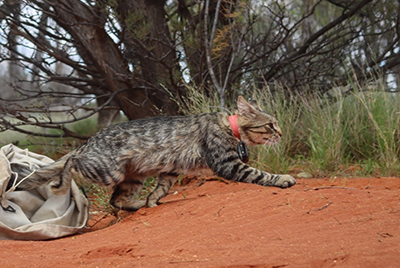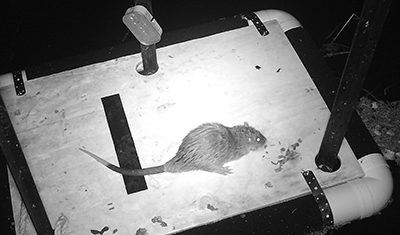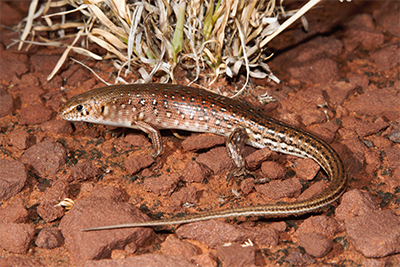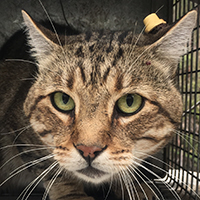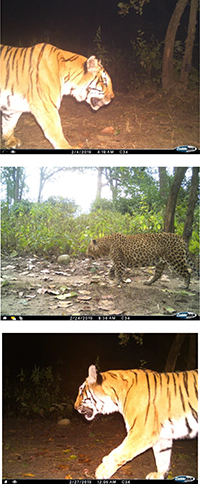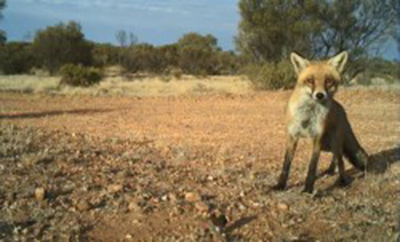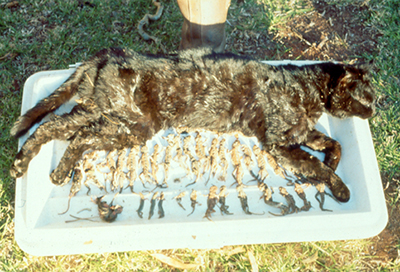Exotic ungulates are expanding throughout the Southern Cone countries of South America. We conducted a quasi-experimental trial to test whether overnight sessions of controlled shooting over bait were more effective for culling axis deer and wild boar than were the routine daytime sessions in a protected area of north-eastern Argentina. Overnight sessions harvested proportionally more deer and fewer wild boar, more adults, pregnant hinds and sows, and significantly heavier deer and wild boar males, than did daytime sessions. Photograph by Alfredo Sabaliauskas.
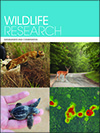
Wildlife Research
Volume 51 Number 6 2024
Feral cats are one of the most harmful invasive species in Australia, and are often caught and collared as part of scientific study to investigate their impacts and inform management. We evaluated the impacts of this process on feral cats. Even though collar weight had no impact, repeated recaptures reduced cat weight. Researchers should consider prioritising fewer capture and handling events over collar-weight reductions, or offset the effect of repeated capture by allowing recovery time greater than 30 days before subsequent recapture attempts. Photograph by Darcy Whittaker.
WR24024 Abstract | WR24024 Full Text | WR24024PDF (753 KB) Open Access Article
Cryptic semi-aquatic mammals present a particular challenge to monitor because of their unique lifestyles. We aimed to identify the most effective methods to detect the seldom-studied rakali, a native Australian semi-aquatic mammal; spotlighting and camera traps placed over water provided the greatest detection probabilities. We present a novel method to monitor rakali, which has the potential to improve the detection and conservation of other small semi-aquatic mammals. Photograph by Emmalie Sanders.
WR24002 Abstract | WR24002 Full Text | WR24002PDF (2.1 MB) | WR24002Supplementary Material (1.3 MB) Open Access Article
Ecological surveillance monitoring targets multiple taxonomic groups using standardised sampling across large spatial scales. We assessed the adequacy of a general fauna-monitoring program for sampling reptiles as indicators of ecosystem health in the semi-arid Northern Territory and found insufficient power to detect potential future changes in reptile occupancy. Once ecological associations are understood, monitoring ecological health remotely using techniques such fire-scar mapping to track proportions of long-unburnt vegetation, should be considered over labour-intensive surveillance monitoring for reptiles. Photograph by Peter J. McDonald.
Feral cats have caused the decline of many native Australian species, but cat management remains challenging with programs being variable in their success. Experts from Australia identified the techniques currently used in cat management and the environmental, economic, and social impacts influencing their success. We summarise the impacts that vegetation, land-use, legislation, and social licence can have on the efficacy of different management techniques. Image by Guy Ballard.
WR23107 Abstract | WR23107 Full Text | WR23107PDF (937 KB) | WR23107Supplementary Material (1.6 MB) Open Access Article
The larger carnivores often influence a top–down regulation on mesopredator behaviour. This study aimed to assess the response of the leopards to non-breeding tigers and its probable link with the conflict with humans, and showed that leopards avoided tigers and increased in substantial numbers, with transient individuals likely to be dispersing and causing conflict. We make recommendations to study the coexistence of copredators and transient animals. Photograph by Wildlife Institute of India.
Non-target impacts of baiting programs may prevent the participation of landholders in red fox control. We field-trialled a collar for the canid-pest ejector (CPE) that prevented wild dogs from triggering the CPE, while allowing foxes to do so. Collared CPEs have the potential to improve the efficacy of baiting programs for foxes and encourage greater participation by landholders, particularly where impacts on non-target canids are considered undesirable. Photograph by Northern Territory Government.
Cat hunting selectivity has the potential to influence trophic cascades and conservation status of wildlife, including many species threatened by cat predation. Analyses of a 27-year dataset of over 2000 cats and 4000 prey items identified species and guilds disproportionately hunted by cats relative to their availability. Implications of prey selectivity for conservation planning are described. Photograph by John Read.



